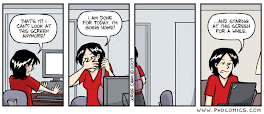Behavior of astigmatic people
 A low degree of astigmatism USUALLY causes more symptomatology, because the visual system tries to compensate it, and does not show blurred vision symptoms; therefore, at the beginning people do not usually associate the symptoms to a vision problem.
A low degree of astigmatism USUALLY causes more symptomatology, because the visual system tries to compensate it, and does not show blurred vision symptoms; therefore, at the beginning people do not usually associate the symptoms to a vision problem.- The main symptom is the distorted and blurred vision in high astigmatism; and headache, visual strain, ocular itching and red eyes in low astigmatism.
As I explained in a previous post, a young hyperopic person with the low degree is able to “disguise” her disorder if her accommodative function works correctly. But in the case of an astigmatic person, although her accommodation is in correct condition, it “gets crazy”, because it has several points or images that fall in different planes regarding the retina; accommodation is constantly trying to focus all of them, without distinction. The closest points of the retina will cause less tension, but those that are farther will be more difficult to compensate. Visual system will be exhausted and the symptoms (red eyes, itching, burning, tearing, headache, visual strain,…) will appear.
- Although a person with astigmatism is usually born with it, if this is low, she could compensate it during the infancy. But as the child grows up and the school request is higher (more number of homework or study hours, more reading, more understanding,…), and her accommodation naturally decreases, the child has got more problems to compensate it; and this moment is when the astigmatism is obvious, showing several symptoms. That is why, many people say their astigmatism appeared between 10 and 20 years old.
- So, an astigmatism will cause more symptoms if it is associated with a hyperopia than with myopia, because hyperopic people have a more exhausted accommodative system due to the excessive effort that she makes to compensate her refractive error.
- That is why astigmatism can also cause learning disabilities.
- It can develop wrong postural habits, like tilting her head when looking far away or looking up close, since when the astigmatic person tilts her head, can find the position in which she sees better, or where the image is less distorted. This can cause cervical problems in the long run.
- “Blurred” or double vision greater at near than at distance.
- While she reads, she jumps the line or the letters seem to be moving.
- Visual strain and feeling sleepy.
- Headache mainly in the fronthead and in the eyes.
- Photophobia (light sensitivity).
- Frequent conjunctivitis or blepharitis.
Refractive disorders: Astigmatism.(1) Vision
Refractive disorders: Astigmatism. (2) Appearance
Refractive disorders: Astigmatism. (3) Different features
Refractive disorders: Astigmatism. (5) Solutions
Refractive visual disorders. Some clarifications.
Some numbers...






No comments:
Post a Comment